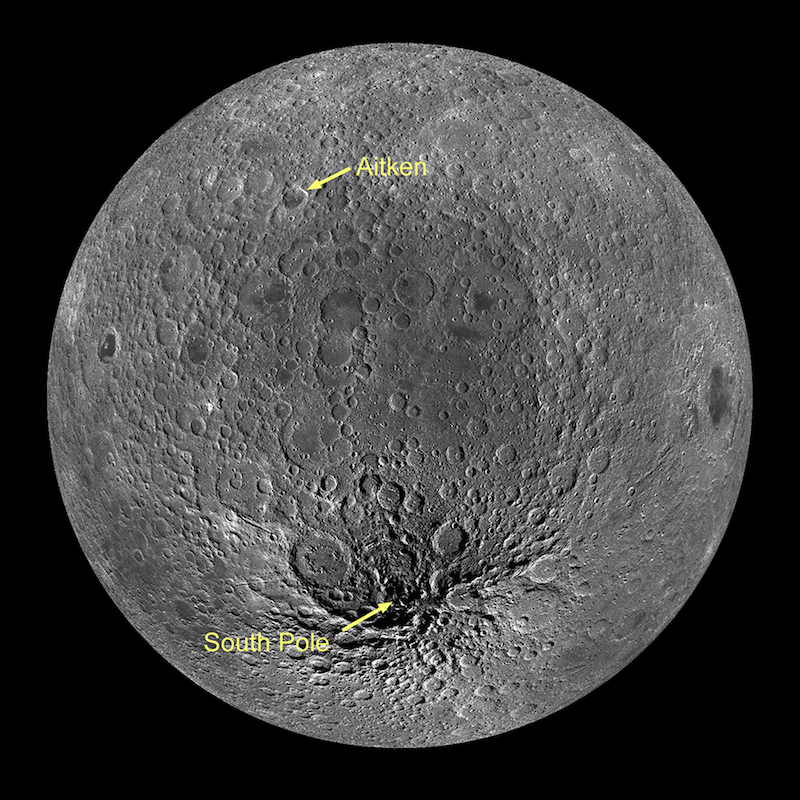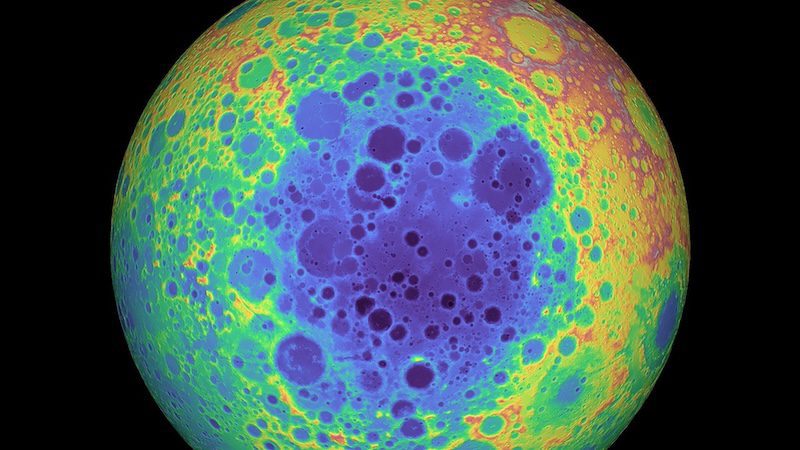- The South Pole-Aitken basin is the largest impact crater on the moon. Its 1,550-mile (2,500-km) expanse also makes it one of the largest known impact craters in the solar system.
- Scientists thought the basin was oval in shape. This is the shape that would form if the impacting asteroid hit the moon at a low angle.
- But a new study shows the massive crater is more circular. The researchers studied mountains around the edge of the basin to determine its original shape.
South Pole-Aitken basin is the moon’s largest crater
The moon is covered in craters. The South Pole-Aitken basin is the largest crater on the moon, resulting from a massive impact billions of years ago. It sits on the moon’s far side, stretching from the South Pole to a crater named Aitken, thus its name. For a long time, scientists thought this huge crater was oval-shaped, forming when an asteroid hit the moon at a shallow angle. But on December 6, 2024, a research team led by the University of Maryland said the basin is more circular than scientists previously thought.
The finding, based on data from NASA’s Lunar Reconnaissance Orbiter (LRO), also has implications for NASA’s plans to send astronauts to the lunar South Pole as part of the Artemis missions.
The researchers published their peer-reviewed results in Earth and Planetary Science Letters on November 28, 2024. The paper will also be in Volume 650 of the journal, on January 25, 2025.
Moon’s largest crater rounder than previously thought
The South Pole-Aitken basin is enormous, about 1,550 miles (2,500 km) across. In fact, that’s nearly a quarter of the circumference of the moon. It’s one of the largest known impact craters in the solar system.
Scientists thought the basin was more oval shaped than circular. That would mean the impacting asteroid that created it hit the lunar surface at a shallow angle. But the new study suggests the crater is rounder. Hannes Bernhardt, an assistant research scientist in the University of Maryland’s Department of Geology is the lead author. He said:
It’s challenging to study the South Pole-Aitken basin holistically due to its sheer enormousness, which is why scientists are still trying to learn its shape and size. In addition, 4 billion years have passed since the basin was originally formed and many other impacts have obscured its original appearance. Our work challenges many existing ideas about how this massive impact occurred and distributed materials, but we are now a step closer to better understand the moon’s early history and evolution over time.
Mountains provide a clue
So, how did the researchers determine the basin is more circular? They used high-resolution images from NASA’s Lunar Reconnaissance Orbiter to study mountain formations around the edge of the basin. They found more than 200 of these mountain formations. The scientists think they’re remnants from the original impact. The new data revealed something interesting. If the original impact likely created a more circular crater, it would have spread debris across the moon’s South Pole, where the Artemis astronauts will land. As Bernhardt said:
A rounder, more circular shape indicates that an object struck the moon’s surface at a more vertical angle, possibly similar to dropping a rock straight down onto the ground. This circular impact implies that debris from the impact is more equally distributed around it than was originally thought, which means that Artemis astronauts or robots in the South Pole region may be able to closely study rocks from deep within the moon’s mantle or crust; materials that are typically impossible for us to access.

Insight into the moon’s origin
Being able to study these rocks is good news for the upcoming Artemis missions. They could provide valuable clues about the moon’s interior and how the moon first formed. The impact would have sprayed material from the moon’s lower crust and upper mantle. Much of that material should still be sitting on the surface, waiting for astronauts or robots to collect samples for study. As Bernhardt noted:
One of the most exciting implications of our research is how it is applicable to missions to the moon and beyond. Astronauts exploring the lunar South Pole might have easier access to ancient lunar materials that could help us understand how the moon and our solar system came to be.
Chandrayaan-3 mission findings support new study
In addition, India’s Chandrayaan-3 mission landed near the lunar South Pole on August 23, 2023. Among its findings, the rover discovered minerals that indicated impact debris came from the mantle close to the South Pole. This supported the theory that the impact was more head-on than at an angle.
In 2019, scientists reported the discovery of an unusual large mass of material beneath the South Pole-Aitken basin. It likely extends more than 200 miles (320 km) deep. Scientists think it consists of metal and leftover material from the asteroid impact that created the basin.
Bottom line: The South Pole-Aitken basin is the moon’s largest crater. Scientists have thought it was oval-shaped, but a new study suggests it’s more circular.
Read more: ‘Time capsule’ moon samples reveal moon’s history
Read our previous article: Humpback whale breaks record for longest migration
